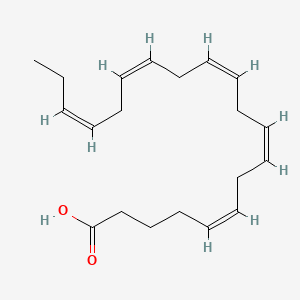| Shahar E et al. |
Docosahexaenoic acid and smoking-related chronic obstructive pulmonary disease. The Atherosclerosis Risk in Communities Study Investigators. |
1999 |
Am. J. Respir. Crit. Care Med. |
pmid:10351918
|
| Meuillet EJ et al. |
Incorporation of exogenous lipids modulates insulin signaling in the hepatoma cell line, HepG2. |
1999 |
Biochim. Biophys. Acta |
pmid:10354513
|
| Nakamura N et al. |
Joint effects of HMG-CoA reductase inhibitors and eicosapentaenoic acids on serum lipid profile and plasma fatty acid concentrations in patients with hyperlipidemia. |
1999 |
Int. J. Clin. Lab. Res. |
pmid:10356659
|
| Kotkat HM et al. |
Effect of dietary fish oil (active EPA-30) on liver phospholipids in young and aged rats. |
1999 |
Comp. Biochem. Physiol., Part A Mol. Integr. Physiol. |
pmid:10356759
|
| Barichello JM et al. |
Enhanced rectal absorption of insulin-loaded Pluronic F-127 gels containing unsaturated fatty acids. |
1999 |
Int J Pharm |
pmid:10361163
|
| Morita I |
[Regulation of angiogenesis-expression of VEGF receptors]. |
1998 |
Hum. Cell |
pmid:10363159
|
| Bayorh MA et al. |
Enhanced nitric oxide synthesis reverses salt-induced alterations in blood flow and cGMP levels. |
1999 |
Clin. Exp. Hypertens. |
pmid:10369379
|
| Hussey HJ and Tisdale MJ |
Effect of a cachectic factor on carbohydrate metabolism and attenuation by eicosapentaenoic acid. |
1999 |
Br. J. Cancer |
pmid:10376976
|
| Madsen L and Berge RK |
3-Thia fatty acid treatment, in contrast to eicosapentaenoic acid and starvation, induces gene expression of carnitine palmitoyltransferase-II in rat liver. |
1999 |
Lipids |
pmid:10380116
|
| Katsumata T et al. |
Delayed administration of ethyl eicosapentate improves local cerebral blood flow and metabolism without affecting infarct volumes in the rat focal ischemic model. |
1999 |
Eur. J. Pharmacol. |
pmid:10395096
|
